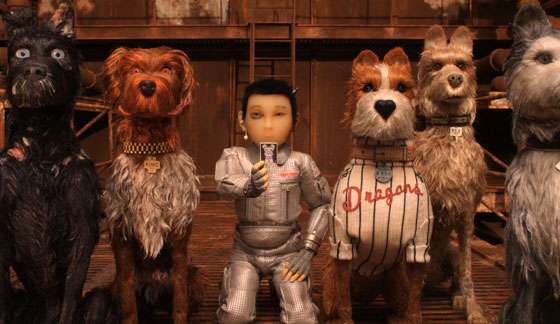Starring the Voices Of: Bryan Cranston, Koyu Rankin and Edward Norton
Directed By: Wes Anderson
Rated: PG-13
Running Time: 101 minutes
Fox Searchlight Pictures
Since bursting on to the scene in the mid-90s, Wes Anderson has had a steady and solid film catalogue. Even his average movie has an enchanting whimsical nature to it and is never visually boring. He may have a few blemishes, but none of his films had me believing the film was a complete misfire. So there shouldn’t be any kind of flirting on my end with you, the reader, on whether or not I enjoyed “Isle of Dogs,” because I did.
In Anderson’s alternate universe, a dog-flu virus has spread throughout the population, and not just the canine one. The solution, by authoritarian leader Kobayashi (Kunichi Nomura), is to have all dogs banished to Trash Island. The isle is a culmination of man-made disasters, mankind’s carelessness with experimentation, and of course, trash. Making his way onto the island, via a small makeshift aircraft, is Atari (Rankin), who’s looking for his guard dog, Spot.
Helpining Atari around the island is Chief (Cranston), Rex (Norton), King (Bob Balaban), Boss (Bill Murray) and Duke (Jeff Goldblum); a pack made up of alpha dogs with their own individual quirks. Like most Anderson films, the cast is filled with a who’s who of Hollywood’s past and present. Some of the surprising ones are Harvey Keitel, Liev Schreiber and Yoko Ono. While each voice may not seem recognizable at first, their character certainly brings a flash in the pan of joy, humor or bite to the scene they’re in.
While Trash Island is its own visual character, the nearby Japanese city of Megasaki looks like a tourist greeting card. It may be off putting to some viewers because there are no subtitles for our Japanese characters. Sometimes we only understand the human characters because of stylish visual storying telling, or an English translator for the moments of broadcast news (which seems odd that a Japanese TV station would have an English translator, but I could easily be wrong about that). I can’t speak to the authenticity some of the film’s culturally significant moments or the settings, having never grown up in Japan and having a basic American public school system understanding of the island nation.
Even though the stop-motion animation screams “kid’s movie,” it’s not. The deliberate peculiarities in the film add to its charm or help build the sinister undertones running beneath Kobayashi’s leadership. The film’s subtlety mainly makes remarks about unity and loyalty, and how both of those can be good to the extreme, but on the same scope, be used to pursue evil endeavors. As to whether or not that message has been adapted to fit a more contemporary narrative, instead of a universal one, is unseen.
Visually, “Isle of Dogs” is one of Anderson’s best. Narratively, it’s sometimes deflating, but still overwhelmingly charming and loveable. The film’s sentimentality and warmth is thoroughly earned. On a basic level, “Isle of Dogs” is Anderson’s straightforward love letter to man’s best friend. Some of the individual tics for each of the characters are something dog current and former dog owners will pick up on. Even cat lovers might find something to smile at by the time the film ends.



